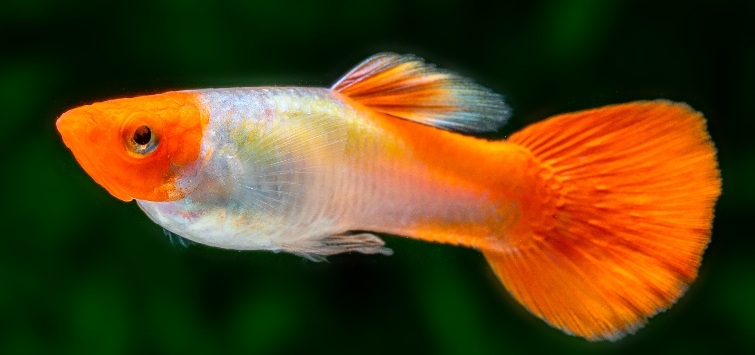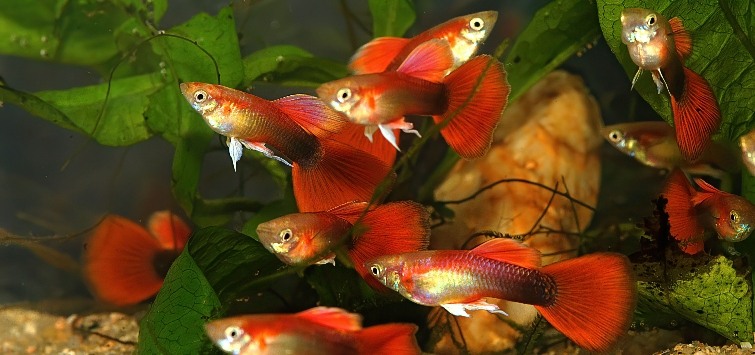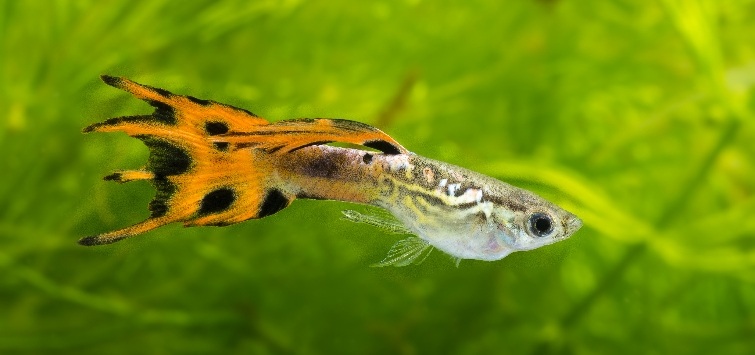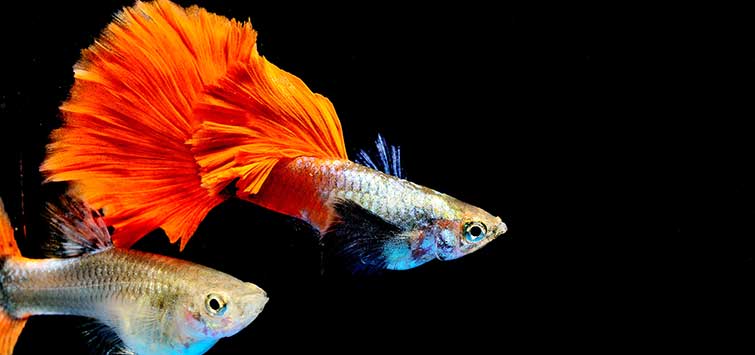A Rainbow of Gorgeous Guppies: Care, History, & Beyond
Mike Hellweg
The humble guppy. Small, beautiful, gregarious, active, intelligent, and simply a joy to behold. You’d be hard pressed to watch a tank full of gorgeous guppies and not smile. Children love them, and they have plenty of appeal for adults, too.
Guppies quickly learn who is the source of their food on the other side of the glass and charge up and down the glass in front of that person. They wiggle their colorful tails, dancing for their next meal.
In past generations, they were often referred to as the “missionary fish,” as their endearing behavior and striking colors brought countless hobbyists into the fold. Before the aquarium hobby, early explorers in their native lands referred to them as the “millions fish” because they were located everywhere and reproduce prolifically.
What’s more, they are inexpensive, hardy, easy to keep, and easy to breed; they can be kept and successfully bred by novice hobbyists. Yet, guppy care can present vexing challenges for even the most accomplished breeders.
They are derogatorily referred to as “feeders” by some folks who haven’t experienced the joy of keeping them, but others revere them above all fish and spend their lives perfecting a particular strain. Some hobbyists really go off the deep end and have a dedicated room filled with dozens of aquaria of just guppies, often with only one or two strains. These fanatics happily share the results of their hard work in a circuit of fancy guppy shows around the country.
Ask just about anyone anywhere in the world, and they will likely have heard of guppies. The name has come to be synonymous with small, colorful fish.
Some Guppy History

Yet in the middle of the 19th century, when Abraham Lincoln was still an obscure politician from Illinois, guppies were likewise unknown and just being described to science for the first time. It seems that every population on almost every island in the southern Caribbean and along the northern coast of South America has a distinct color pattern. This variability led to each population getting its own scientific name.
Over the years, the diminutive guppy has been known to science by nearly two dozen names and/or spellings. Surprisingly, after all of this, today we know it by the original scientific name it was given in 1859, Poecilia reticulata.
Colorful Males & Flashy Tails
It’s no surprise that they drew attention even before the aquarium hobby was even established. Male wild guppies are mesmerizingly flashy. They sport an endless variety of coloration, with red, orange, blue, green, gold, silver, and black spots, blotches, and even sometimes stripes. Some specimens show white, red, yellow, and/or orange colors in the unpaired fins as well, and even exhibit fin ray extensions in the dorsal and caudal fin.Every male is somewhat different than his siblings. Most wild males top out at about 1 inch (2.5 cm). Being tiny and flashy might help them get the attention of the ladies, but it also draws predators like a neon sign. So, for their survival, guppies have evolved an interesting spawning strategy.
Unlike most fish, which lay eggs, guppies bear living young ready to fend for themselves shortly after birth. The males spend much of their short life chasing and courting females, and hopefully successfully internally fertilizing them with their highly modified anal fin, known as a gonopodium. In addition, females have the ability to store the males’ sperm packets to fertilize future batches of fry potentially long after their father has moved on.
Females & Their Fry
Wild females are basically a plain olive-gray to silvery gray with colorless fins. They have a large brownish to bluish triangular spot above the anal fin known as the “gravid spot.” If you look closely at a large female, you can often see the eyes of the developing embryos inside her. Every four weeks she can drop a litter of a couple dozen guppy fry, with smaller females dropping fewer and larger females being able to drop several dozen.The fry are immediately able to fend for themselves, which is helpful because even a good mother guppy is not above consuming a few of her young. They spend their first few weeks hunting for miniscule food items in the very shallow water where most aquatic predators can’t get to them and hiding among dense plants where terrestrial predators can’t see them.
In our aquaria, we simulate this by providing the fry with plenty of floating plants as cover. The added bonus here is that the surface of the floating plants is also covered with microfauna that the young guppy fry feed upon between provided meals. They grow quickly, and some are able to reproduce by the time they are just three months old.
Guppy Care & Feeding

Guppies make great community fish with other small, peaceful tankmates like most tetras, most barbs (but not tiger barbs), rasboras, danios, smaller rainbowfish, other livebearers, and similar community fish. But an argument can be made for keeping them in a species-only tank where they are the sole inhabitants, except maybe a few catfish to add some activity to the lower levels of the tank.
Some hobbyists keep them with shrimp, but over time the guppy’s persistent inquisitiveness will drive the shrimp into hiding, or even stress them to the point of death. Over the long term, shrimp are not great companions for them. The same goes for snails—guppies just love to pick at their antennae. They’re not aggressive, just playful, but the snails don’t know that.
While a small group can be kept in one of the nano tanks that are so popular these days, the optimal home for a colony of guppies is a 29-gallon (about 110-liter) tank. This will give them plenty of room to move about and lots of water column space to explore, plus plenty of space to interact with and watch you as well.
The best place to put them is in a room where you will be spending most of your time, as you’ll want to spend time watching the show. Don’t set them near your desk if you have a lot of work to do, as you’ll find yourself looking at your guppies and completely forget about being productive!
The tank should be planted around the sides and back, along with some floating plant material to give the babies a place to hide. An air-driven sponge filter is all the filtration you need, though a gentle flow from an outside power filter or canister filter will work as well. Whichever type you choose, pick one that you can easily maintain, and do so according to the manufacturer’s instructions. Finally, a heater set at about 76°F (24°C) completes the picture.
Guppies are greedy eaters and will consume just about any food that is offered. A good commercial flake or granulated food with some color enhancers will serve as a perfect staple diet. A couple of times a week, add a vegetable-based flake, and maybe once a week add small frozen or live foods to round out their diet. Newly hatched baby brine shrimp are a popular choice, and most breeders use them as a daily diet for both the fry and the adults, along with a staple flake or granulated food.
Feeding good food is a key for success with producing beautiful, big guppies. Some breeders feed their fish small meals several times a day, and then siphon any uneaten food from the bottom late in the day, using this as an opportunity to perform a water change as well.
Water changes are very important for guppy care. Many breeders and producers of show guppies perform daily water changes to maintain high water quality and get optimal growth and fin development, but for a single show tank, changing a third to half of the water once every week to 10 days is more than enough.
Selecting the Right Guppies for You

Most folks find that the best place to get good-quality fish is at a local aquarium club, where they can meet local breeders. Attend club auctions or swaps, and you should be able to find an almost overwhelming number of choices. You can also join the International Fancy Guppy Association (IFGA), where you’ll be able to find show-quality stock. But if you’re just looking for colorful fish, your local fish store should be more than able to help.
Most of the time guppies are sold as either pairs or trios. If you have the option, start with a couple of trios of the same variety. The extra females help spread the males’ affections around so that no single female is getting all the attention all of the time. If you’re not interested in breeding, set up a tank of just males, which can be spectacular. Often breeders are more than happy to sell off their excess males, as that will leave them with more females for their own breeding projects or for other customers wanting trios instead of pairs.
Most of the guppies available today are known as veiltails or delta tails. Both males and females have large, colorful tails, and nowadays many females are almost as brightly colored as the males. Guppies can have bodies that are half black, solid black, gold, albino, solid red albino, blue, snakeskin with different color backgrounds and black spots, metallic blue, and many other colors.
Their fins can be colored the same as the body as in solid red, solid blue, or solid black, or they can be different colors like half-black pastels, snakeskin bodies with yellow, red, white, or blue unpaired fins, or literally hundreds of other color combinations. Usually, the more desirable fish have matching dorsal and caudal fins, but some folks enjoy the mixed colors.
Speaking of caudal fins, there is an almost endless variety of patterns of ray development. In addition to delta and veiltails, there are halfmoons that have massive, half-moon-shaped tails; fantails that are a bit smaller than veil/delta tails; scarf tails (or flagtails) that are elongate and straight; lyretails with several of both the upper and lower rays of the caudal extended; upper swords, lower swords, and double swords with just a few rays of the caudal extended, sometimes as long as the fish’s body; pintails and speartails that have the center rays extended in different patterns; and roundtails, which are similar in shape to a wild fish’s tail. There are even crowntails that have every caudal ray extended.
A Guppy (or Lots of Them) for Everyone
There truly is a guppy to suit just about anyone’s taste. New color patterns and fin shapes appear all of the time as breeders strive to perfect their particular strain or try something new. Who knows? You could even be the person who comes out with the next popular variety! That’s just one of the many great things about the gorgeous guppies.
And, as always, don’t forget to spend some time just sitting and watching your guppies. I guarantee it will put a smile on your face and help your troubles melt away.

.png?h=595&iar=0&w=2781&hash=5FD5E69473BCC22199FBFA2FB71B6033)



